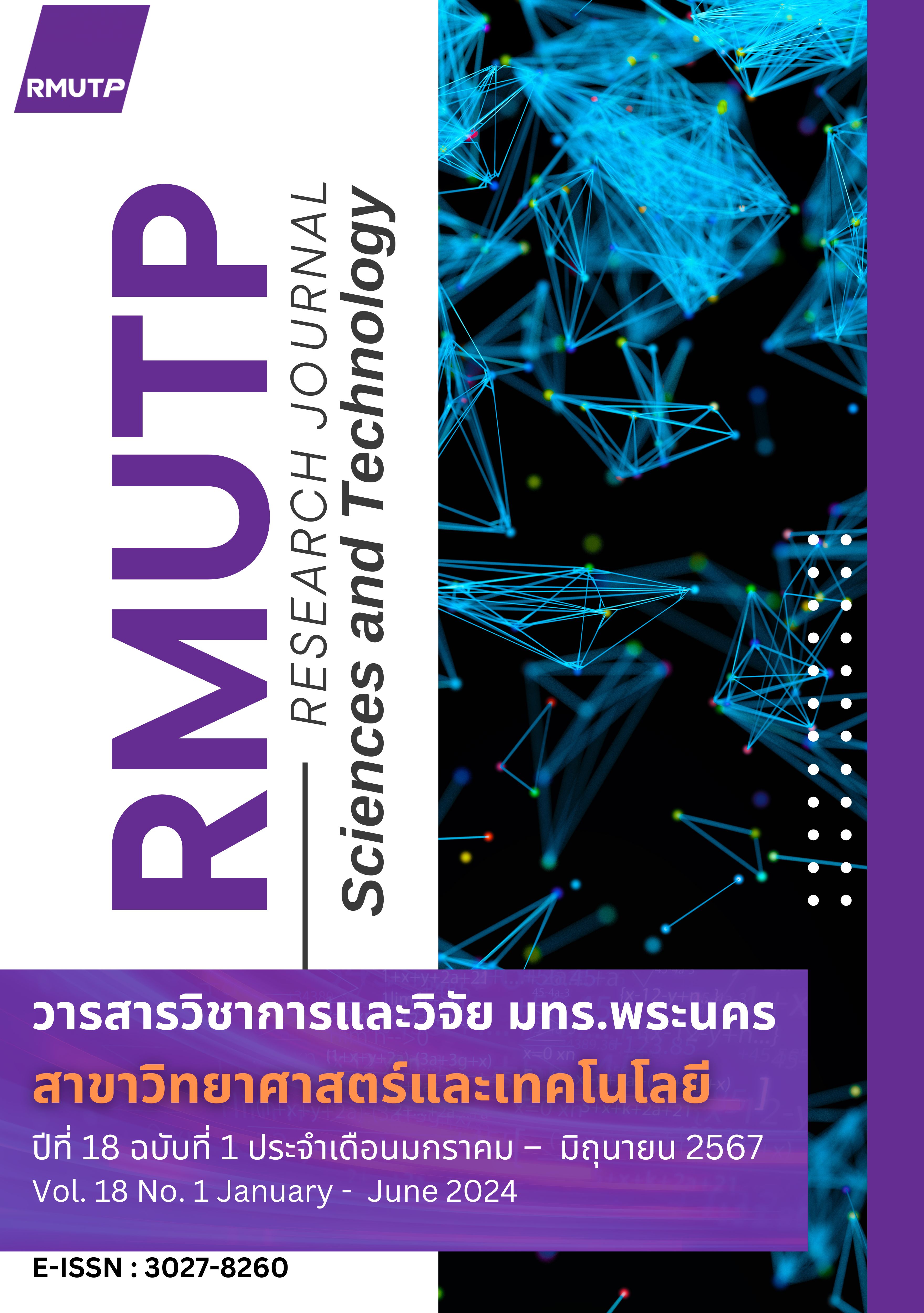การประเมินสมรรถนะของระบบปรับอากาศแบบไฮบริดระหว่างเครื่องทำความเย็นแบบน้ำระเหยและเครื่องปรับอากาศแบบอัดไอ
Main Article Content
บทคัดย่อ
ระบบปรับอากาศแบบไฮบริด ประกอบด้วย เครื่องทำความเย็นแบบน้ำระเหย และเครื่องปรับอากาศแบบอัดไอทั่วไปถูกตรวจสอบและประเมินสมรรถนะในการศึกษานี้ อาคารขนาด 2.30 m X 2.30 m X 2.75 m ถูกสร้างขึ้นที่มหาวิทยาลัยเทคโนโลยีสุรนารี นครราชสีมา มีการติดตั้งเครื่องปรับอากาศแบบอัดไอในอาคาร เครื่องทำความเย็นแบบน้ำระเหยสัมผัสโดยอ้อม 5 ชนิดที่แตกต่างกัน ถูกสร้างและติดตั้งในอาคาร เครื่องทำความเย็นดังกล่าว ได้แก่ เครื่องทำความเย็นแบบน้ำระเหยแบบวัฏจักรเอ็ม, เครื่องทำความเย็นแบบน้ำระเหยชนิดไหลตั้งฉากแบบนำอากาศกลับสู่ช่องเปียก, เครื่องทำความเย็นแบบน้ำระเหยชนิดไหลตั้งฉาก, เครื่องทำความเย็นแบบน้ำระเหยชนิดไหลสวนทางแบบมีแผ่นกั้น และเครื่องทำความเย็นแบบน้ำระเหยชนิดไหลสวนทาง ผลการทดสอบพบว่า เครื่องทำความเย็นแบบน้ำระเหยชนิดไหลตั้งฉากให้ค่าสมรรถนะการทำความเย็นและประสิทธิผลกระเปาะเปียกสูงสุดเมื่อเปรียบเทียบกับอีก 4 ชนิด โดยสมรรถนะการทำความเย็นและประสิทธิผลกระเปาะเปียกสูงสุด คือ 11.68 และ 0.97 ตามลำดับ เครื่องทำความเย็นแบบน้ำระเหยชนิดดังกล่าวสร้างได้ง่าย เนื่องจากมีความซับซ้อนภายในเครื่องน้อยเมื่อเปรียบเทียบกับอีก 4 ชนิด ดังนั้น จึงเลือก เครื่องทำความเย็นแบบน้ำระเหยชนิดไหลตั้งฉาก การติดตั้งเครื่องทำความเย็นแบบน้ำระเหยภายนอกอาคาร พบว่า สามารถลดการใช้พลังงานได้ถึง 30.77% เมื่อเปรียบเทียบกับการติดตั้งภายในอาคาร นอกจากนี้ การสเปรย์น้ำไม่ต่อเนื่องบนเครื่องทำความเย็นนั้นดีกว่าการสเปรย์น้ำต่อเนื่อง การสเปรย์น้ำ 5 min ทุก 2 h สามารถลดอุณหภูมิหลังผ่านเครื่องทำความเย็นแบบน้ำระเหยลงได้ 8 °C
Article Details

อนุญาตภายใต้เงื่อนไข Creative Commons Attribution-NonCommercial-NoDerivatives 4.0 International License.
ลิขสิทธ์ ของมหาวิทยาลัยเทคโนโลยีราชมงคลพระนครเอกสารอ้างอิง
Q. Chen, M. Kum Ja, M. Burhan, F. Hassan Akhtar, M. Wakil Shahzad, D. Ybyraiymkul, K. Choon Ng, “A hybrid indirect evaporative cooling-mechanical vapor compression process for energy-efficient air conditioning,” Energy Conversion and Management, Vol. 248, pp. 114798, 2021.
R. Tariq, N. Ahmed Sheikh, J. Xaman, A. Bassam, “Recovering waste energy in an indirect evaporative cooler – A case for combined space air conditioning for human occupants and produce commodities,” Building and Environment, Vol. 152, pp. 105-121, 2019.
D. Pandelidis, A. Cichon, A. Pacak, S. Anisimov, P. Drag, “Performance comparison between counter- and cross-flow indirect evaporative coolers for heat recovery in air conditioning systems in the presence of condensation in the product air channels,” International Journal of Heat and Mass Transfer, Vol. 130, pp. 757-777, 2019.
V. Jain, S.C. Mullick, Tara C. Kandpal, “A financial feasibility evaluation of using evaporative cooling with air-conditioning (in hybrid mode) in commercial buildings in India,” Energy for Sustainable Development, Vol. 17, pp. 47-53, 2013.
M. Wakil Shahzad, M. Burhan, D Ybyraiymkul, S. Jin Oh, K. Choon Ng, “An improved indirect evaporative cooler experimental investigation,” Applied Energy, Vol. 256, pp. 113934, 2019.
D. Bishoyi, K. Sudhakar, “Experimental performance of a direct evaporative cooler in composite climate of India,” Energy and Buildings, Vol. 153, pp. 190-200, 2017.
S.A. Nada, A. Fouda, M.A. Mahmoud, H.F. Elattar, “Experimental investigation of energy and exergy performance of a direct evaporative cooler using a new pad type,” Energy and Buildings, Vol. 203, pp. 109449, 2017.
J. Chua, W. Xu, Yijun Fu, H Huo, “Experimental research on the cooling performance of a new regenerative dew point indirect evaporative cooler,” Journal of Building Engineering, Vol. 43, pp.102921, 2021.
P. Patunkar, S. Dingare, “Performance investigations of cross flow indirect evaporative cooler,” Materialstoday PROCEEDINGS, Part 11, Vol. 47, pp. 2915-2918, 2021.
D. Pandelidis, A. Cichon, A. Pacak, Anisimov, P. Drag, “Counter-flow indirect evaporative cooler for heat recovery in the temperate climate,” Energy. Vol. 165, Part A, pp. 877-894, 2018.
D. Pandelidis, A. Cichon, A. Pacak, Anisimov, P. Drag, M. Drag, W. Worek, S. Cetin, “Performance study of the cross-flow Maisotsenko cycle in humid climate conditions,” International Communications in Heat and Mass Transfer. Vol. 115, pp. 104581, 2020.
H Kim, S Ham, D Yoon, J Jeong, “Cooling performance measurement of two cross-flow indirect evaporative coolers in general and regenerative operation modes,” Applied Energy. Vol. 195, Pages 268-277, 2017.
A.E. Kabeel, M. Abdelgaied, R. Sathyamurthy, T. Arunkum, “Performance evaluation and parameter sensitivity analysis of a membrane-based evaporative cooler with built-in baffles,” Applied Thermal Engineering. Vol. 208, pp. 118228, 2017.
R. Tariq, N. Ahmed Sheikh, J. Xamán, A. Bassam, “Recovering waste energy in an indirect evaporative cooler – A case for combined space air conditioning for human occupants and produce commodities,” Building and Environment. Vol. 152, pp. 105-121, 2019.
Y. Wan, Z. Huang, A. Soh, X. Cui, K. Jon Chua, “Analysing the transport phenomena of novel dew-point evaporative coolers with different flow configurations considering condensation,” International Journal of Heat and Mass Transfer. Vol. 170, pp. 120991, 2021.
S. Hossein Elahi, S.D. Farhani, “Increasing evaporative cooler efficiency by controlling water pump run and off times,” International Journal of Heat and Mass Transfer. Vol. 127, pp. 105525, 2021.
T. Theamtat, “Modeling and analysis of a hybrid evaporative cooling vapor compression air-conditioning,” Thesis M.Eng. (Mechanical and Process), Suranaree University of Technology, Nakhon Ratchasima, 2019.
C. T’Joen, Y. Park, Q. Wang, A. Sommers, X. Han, A. Jacobi, “A review on polymer heat exchangers for HVAC&R applications,” International Journal of Refrigeration. Vol. 32, pp. 763–779, 2009.
R. Boukhanouf, O. Amer, H. Ibrahim, J. Calautit, “Design and performance analysis of a regenerative evaporative cooler for cooling of buildings in arid climates,” Building and Environment, Vol.142, pp. 1-10, 2018.
2001 ASHRAE Fundamentals Handbook (SI), Chapter 6: Psychrometrics, 6.1–6.17. American Society of Heating, Refrigerating and Air-Conditioning Engineers (2002), Atlanta.
S. Thiangchanta, T. Anh Do, P. Suttakul, Y. Mona, “Energy reduction of split-type air conditioners using a pre-cooling system for the condenser,” Energy Reports, Vol. 7, pp. 1-6, 2021.


